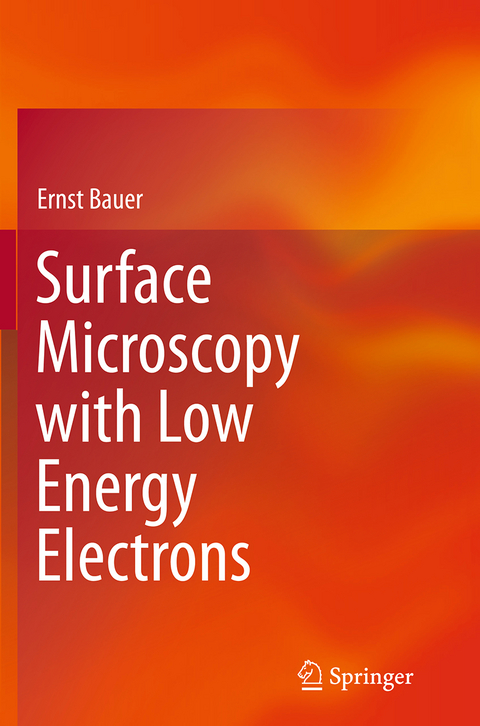
Surface Microscopy with Low Energy Electrons
Springer-Verlag New York Inc.
978-1-4939-3988-6 (ISBN)
Professor Ernst Bauer is a distinguished German-American physicist and surface scientist who has made fundamental contributions to the understanding of epitaxial growth and to the development of microscopy techniques. He is one of the founders of surface physics and the physics of thin films. In 1958 he derived the classification of the thin film growth mechanisms that provides the theoretical framework of epitaxy which is used worldwide to this day. In 1962 he invented LEEM (Low Energy Electron Microscopy), which came to fruition in 1985. In the late eighties/early nineties he extended the LEEM technique in two important directions by developing Spin-Polarized Low Energy Electron Microscopy (SPLEEM) and Spectroscopic Photo Emission and Low Energy Electron Microscopy (SPELEEM). The combination of these methods now allows a comprehensive (structural, chemical, magnetic and electronic) characterization of surfaces and thin films on the 10 nm scale. Ernst Bauer’s interest in the development of synchrotron radiation microscopy techniques and his involvement with the Synchrotron source Elettra in Trieste, Italy resulted in the development of the Nanospectroscopy beamline, which is today one of the leading synchrotron radiation microscopy facilities worldwide. His work directly or indirectly impacts many areas of modern materials science: surfaces, thin films, electronic materials and instrumentation. The invention and development of surface microscopy with slo w electrons has revolutionized the study of surface science and thin film science. Ernst Bauer has authored or co-authored more than 450 publications (among them 85 review papers and book chapters) and one book ("Electron Diffraction: Theory, Practice and Applications", 1958, in German). His papers are widely cited. Numerous LEEM instruments are now installed and are operating in many laboratories and synchrotron radiation facilities around the world (USA, Europe, Asia and Australia). An important recognition for Ernst Bauer’s efforts in the field of surface microscopy is the increasing number of the scientists involved in LEEM research, which is reflected in the organization of bi-annual LEEM/PEEM workshops, the first of which was organized by Ernst Bauer and Anastassia Pavlovska in Arizona in 1998. Broad international collaboration is typical of Ernst Bauer’s research. He had longstanding scientific cooperations with NASA, University of Pretoria (South Africa), Synchrotron Radiation Source in Trieste (Italy), Poland, Ukraine, Bulgaria and Czech Republic. About 80 visiting scientists had a possibility to perform high quality research in his group in Germany. Presently he has collaborations with Japan, Poland, Italy, Germany and Hong Kong. The scientific achievements of Ernst Bauer have been multiply honored. He was the recipient of the E.W. Muller Award in 1985, the Gaede Prize of the German Vacuum Society in 1988, the Medard W. Welch Award of the Ame rican Vacuum Society in 1992, the Niedersachsenpreis for Science (Germany) in 1994, the BESSY Innovation Award on Synchrotron Radiation in 2004 and the very prestigious Davisson-Germer Prize of the American Physical Society in 2005. In 2003 Ernst Bauer received the first Award of the Japan Society of Promotion of Science's 141st Committee on Microbeam Analysis and was made an honorary member of this organization. He was elected a Member of the Goettingen Academy of Sciences in 1989, Fellow of the American Physical Society in 1991 and Fellow of the American Vacuum Society in 1994. In 2008 he was honored with a Humboldt Research Prize and Doctor Honoris Causa at the Marie Sklodovska-Curie University, Lublin, Poland. In 2012 he was appointed Fellow of Elettra Sincrotrone Trieste and in 2014 he received the Doctor Honoris Causa title from the University of Wrocław, Poland. More information can be found: on Ernst Bauer’s website at Arizona State University on Wikipedia: Ernst. G. Bauer
Chapter 1. Introduction.- Chapter 2. Basic Interactions.- Chapter 3. Instrumentation.- Chapter 4. Theory of image formation.- Chapter 5. Applications in surface science.- Chapter 6. Applications in other fields.- Chapter 7. Magnetic imaging.- Chapter 8. Other surface imaging methods with electrons.
| Erscheinungsdatum | 23.09.2016 |
|---|---|
| Zusatzinfo | 71 Illustrations, color; 145 Illustrations, black and white; XIX, 496 p. 216 illus., 71 illus. in color. |
| Verlagsort | New York |
| Sprache | englisch |
| Maße | 155 x 235 mm |
| Themenwelt | Naturwissenschaften ► Biologie |
| Naturwissenschaften ► Chemie ► Analytische Chemie | |
| Naturwissenschaften ► Physik / Astronomie ► Festkörperphysik | |
| Technik ► Maschinenbau | |
| Schlagworte | cathode lens • Cathode lens slow electrons • Electron optics • emission microscopy book • Ernst Bauer • full field imaging • imaging diffraction spectroscopy • LEEM • LEEM explained • LEEM fundamentals and applications • low energy electron microscopes • Low Energy Electron Microscopy • PEEM • PEEM explained • PEEM fundamentals and applications • photoemission electron microscopy • reflection microscopy • Spectroscopic Photo Emission and Low Energy Electron Microscopy • SPELEEM • Spin-Polarized Low Energy Electron Microscopy • SPLEEM • Surface electron microscopy book • Surface electron microscopy multi-method studies • surface imaging • Surface microscopy low-energy electrons • Surface microscopy slow electrons book • thin film research • XPEEM fundamentals and applications |
| ISBN-10 | 1-4939-3988-2 / 1493939882 |
| ISBN-13 | 978-1-4939-3988-6 / 9781493939886 |
| Zustand | Neuware |
| Haben Sie eine Frage zum Produkt? |
aus dem Bereich


